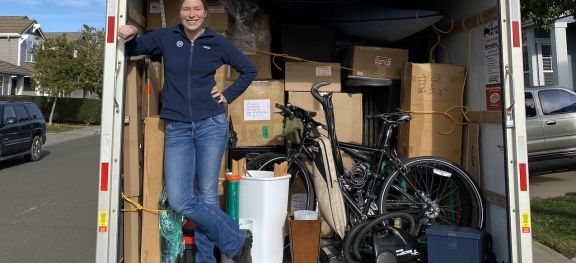Goodbye Napa

3 February 2022 We're republishing this delightful account free today as part of our Throwback Thursday series.
31 January 2022 Our new Pacific Northwest specialist has just packed her bags in California and moved north.
Almost two years ago to the day, I left a wonderful job and a cosy apartment in Oregon, packed my possessions into a storage unit, said goodbye to my friends, and boarded a plane. My plans to return to Portland after harvest in Australia’s Barossa Valley were tentative. A week after leaving, I was offered a vintage position in Kremstal, Austria, following my Australian experience. Then, a friend texted me information about a producer in Central Otago, telling me to bounce to New Zealand in 2021. A producer in Burgundy said they’d take me the second half of 2021… within a month of leaving, there were no plans to return to the US for two years. Until… COVID-19.
Back to the US I went to move in with my grandmother in Washington State. I clung to the idea that I would be able to go to Austria in the fall, but the uncertainty gnawed at me. Without a job, or any conviction that I’d have one, I felt my mental health slipping. I desperately missed work.
An old co-worker/friend called to ask why I didn’t apply for a third vintage in Oregon. ‘I want to learn production methods with a new variety in a new place’, I insisted.
‘Then go to Napa’, he said, ‘do Austria next year.’ I sulked. Napa. Land of overproduced Cabs and conspicuous consumption. I heard him sigh, frustrated by my silent petulance. ‘Sam, there’s a lot to learn in Napa. They make some incredible wine.’ He hung up.
I applied for a position in Napa. I packed my prejudices and moved in July of 2020, just in time for the devastating fires.
I wasn’t entirely wrong. Napa is expensive, exclusive and brand-conscious to a fault. Designer bags, platinum cufflinks, custom suits and large hats parade through the valley every weekend. Tastings are booked months in advance. Bottles of Screaming Eagle, Harlan Estate and Grace Family sit on restaurant tables facing out for the rest of the diners to see. It makes it difficult to go anywhere or to drink the wines you make. Interns are turned away from tasting rooms because the time it would take to serve them can be spent with people who will buy a case of wine that costs $300 a bottle. But that’s part and parcel of living in a tourist area; the place you live isn’t built for you. While that part isn’t ideal, it overlooks the fact that the influx of money facilitates what winemakers, vineyard managers and cellar hands are there for: investment in the wine industry at an incredible scale.
A quick search on winejobs.com will turn up more job openings in Napa than almost any place in the US. At the top wineries where research, development and education are prioritised, people will trade earning potential for knowledge and a name on a resumé. The opportunity to learn on state-of-the-art equipment, to run personal experiments and to correspond with top university research staff and testing laboratories on a wide range of topics is a hefty draw.
Winemakers get to work at 5 am and have already sent a dozen emails about fruit contracts by the time interns walk in at 6 am discussing the weekend. Within minutes the discussion has turned to the latest paper on the AJEV (American Journal of Enology and Viticulture) website. It may not be this way everywhere, but it’s mind-blowing how common it is. Brilliance and talent abound. Work/life balance is virtually nonexistent (unless you own assets) and competition is fierce. One person told me, ‘Our interns would be assistant winemakers anywhere else in the world’. Though braggadocious, he wasn’t wrong. The brainpower in Napa Valley is staggering.
I’ve asked questions in other places in the world and been told, ‘because that’s just how we do it’ or ‘I don’t know but I saw this at the place I worked before, and this method helped’. Not in Napa. A question from an intern is much more likely to lead to them being handed a 20-page research paper or directed to a section of the AWRI website. If there aren’t papers, there are consultants from every part of the world. If the consultants can’t help, wineries will partner with UC Davis to develop solutions and innovations. Any edge discovered is kept as proprietary information for as long as possible. It’s only among close-knit teams that information is traded freely and built upon.
It’s somehow energising and exhausting at the same time. So many passionate, brilliant people who love what they do. So many artificially hushed voices.
While Napa never felt like home, if it hadn’t been for the opportunity to come back to Oregon and write about the Pacific Northwest, I’d still be there. As it was, leaving was hard. For months the feeling of being in over my head made me terribly uncomfortable. By the end, I sought it out. Learning something new every day felt like a guarantee; growth, a foregone conclusion.
I keep reminding myself that leaving Napa doesn’t mean losing that feeling. Instead, my new position with JancisRobinson.com while studying for the Master of Wine qualification gives me the opportunity to ask more producers questions, gather more approaches, and turn around and facilitate knowledge transfer. I wouldn’t give that up for the world. Plus…my proclivity for the Pacific Northwest may have started to chafe at me if I’d stayed in Napa.
But for all those interns out there who have written off Napa Valley, go! Learn. And make no mistake, Napa makes some of the most brilliant wines in the world; they’re just generally way above your budget.
On Friday we plan to publish tasting notes on some of the very special lots in the Napa Valley Library Wine Auction | Direct from the Cellar being conducted online by Sotheby's. The auction is currently open for advance bidding and closes via a live streamed auction this Saturday 5 February om New York at 4pm, 9 pm (London time) and 1 pm PST.
Become a member to view this article and thousands more!
- 15,416 featured articles
- 274,319 wine reviews
- Maps from The World Atlas of Wine, 8th edition (RRP £50)
- The Oxford Companion to Wine, 5th edition (RRP £50)
- Members’ forum
- 15,416 featured articles
- 274,319 wine reviews
- Maps from The World Atlas of Wine, 8th edition (RRP £50)
- The Oxford Companion to Wine, 5th edition (RRP £50)
- Members’ forum
- Commercial use of our Tasting Notes
